356 Buyers Guide.
When considering the purchase of a 356 start by looking at the documentation with the car, make a note of the engine and chassis numbers on the paperwork and make sure they match the numbers on the car. The chassis number is stamped in the boot area in front of the tank. the engine number is on the base of the generator stand and also on the crankcasing itself behind the fan housing which is not an easy space to get to. But beware you could just have a matching front casing.
Also check that the engine number is correct for the car, firstly see if the engine number matches that period of manufacture and check with the register to see if any info is available for the car in question.
Maintenance records will rarely be complete for a vehicle of this age so dont consider this a a major problem, but a lack of history does deserve a more thorough inspection of its mechanics to be sure that the vehicle has been maitained to a decent standard
The main area of concern when looking to purchase a 356 is corrosion, cars of this age had very little in the way of rust protection and the 356's rareity means that panels and chassis parts can be expensive to replace because they are remanufactured on a much smaller scale. Specialist labour is also very thin on the ground, which makes restoration of a rusty example a very expensive proposition.
Where to look:
On the chassis side of things the most important areas are the suspension mounting points, the longitudinal chassis members and the front and rear of the floorplans.
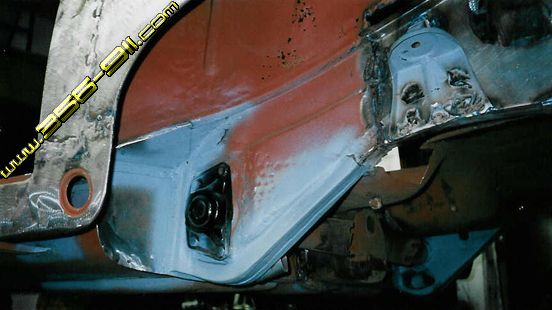
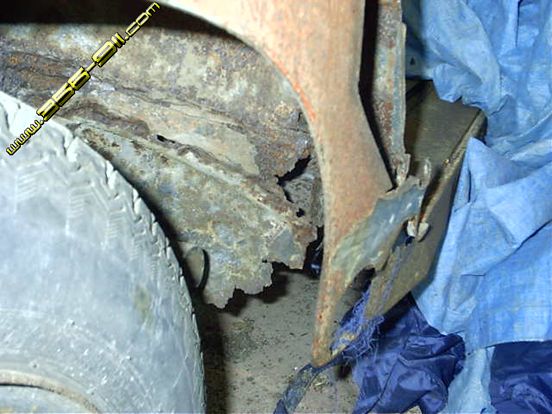
Front of rear arch and tortion bar area of a very rotten 356
This picture shows the suspension mounting points and structural chassis area around the rear wheels. Dirt and damp build up around the trailing arm mounting area can cause rust which will be an expensive and complex repair. Also the damper mounting area as per the repair on this vehicle. The rear of the longitudinal and lock post are also vulnerable and can be checked from this area.
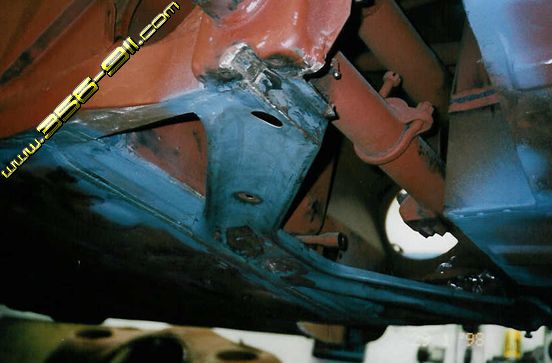
Another Important area to check is under the front of the car around the front suspension as in this picture, this area is of structural importance and is another prime area for corrosion.

This picture of the bare pressed steel chassis shows the side longitudinals without the rocker panel in place. The longitudinals give the 356 its strength from front to rear and are often found to be rotten, these areas deserve careful inspection as its another area where repair/replacement is a complicated and expensive process.
Whilst under the car check for rust in the front and rear of the floorplans and also check for movement in the jacking points, these are common areas for rust, inside the car check the lower area of the front bulkhead and along the inner longitudial where it meets the floor, any sign of dampness in the carpet is a good reason to be very cautious in this area. Check the trim around the lock post for signs of dampness the rear seat area, to the sides of the rear seat base and underneath the rear window.
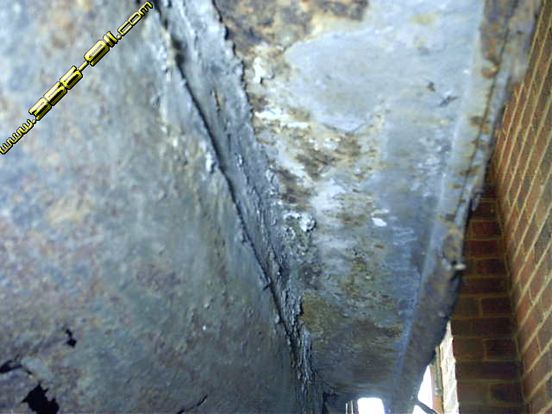
Holes in the longitudial
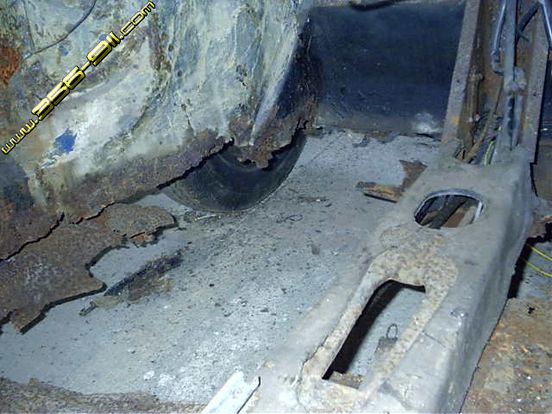
Fred flintstone eat your heart out! Some serious floorpan rot..
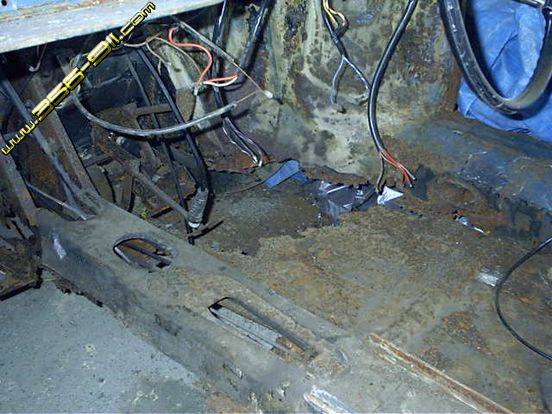
More Floorpan Rot..
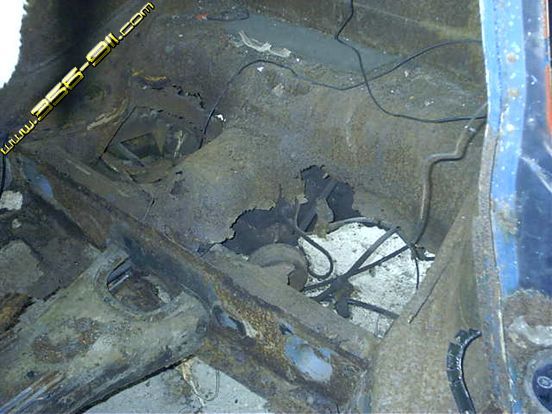
Rear seat area's have rotted through.
Body work can also be a problem and panels can be very expensive to replace, pop the bonnet and check around the edge of the bonnet for corrosion. then remove the spare wheel and check the battery tray area and wheel well, also towards the front of the front inner wing sections as rust can come through here due to a build up around the bumper irons.
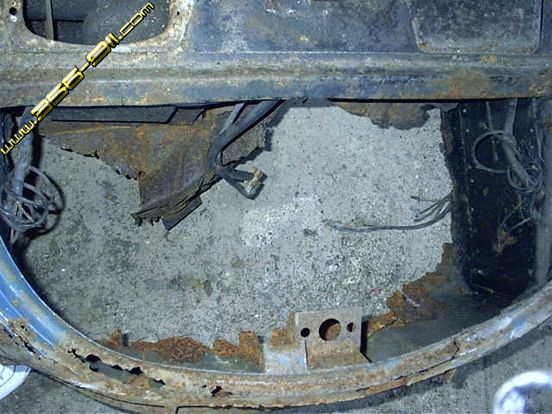
Battery and spare wheel area is a common rot trap
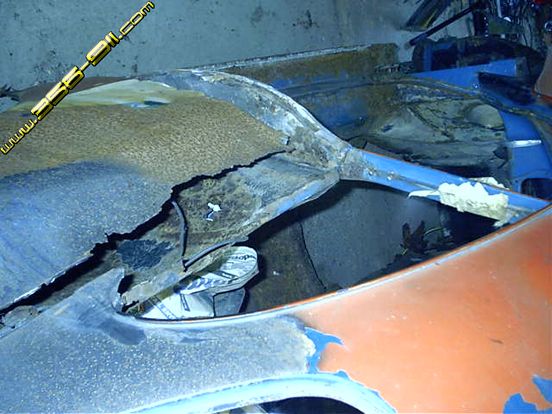
The tops of the rear quarters collect dirt which retains damp and rots
Walk around the car slowly check all the shut lines, then move around and under the front panels around the headlights and wings, then move round to the door bottoms (especially cabriolets) and rear wing panels. Bumpers on early models are fairly expensive remanufactured and even more expensive and hard to find original items so check these thoroughly for dents and rust.
On the up side 356 mechanics in general are long lived, always check for good oil pressure, oil leaks and excessive smoke. The engine is prone to leaks around the oil cooler and rocker areas, though neither should be considered a serious problem.
The front suspension link pins can sometimes seize if not regularly maintained and greased, the bearing surfaces get worn, necessitating the replacement of both pins and bushes. Sloppy steering could be down to worn track rod ends, king pins or the steering box, which is adjustable but only to a certain degree.
When starting the car, make sure its from cold, check that the generator and oil presure lights go out immediately. The oil temperature shouldnt rise on your drive to much over two thirds the way up the scale. The engine of the 356 if built properly should sound like a well oiled sewing machine and be very suspicious of any vendour who tells you otherwise. Any knocking could suggest a problem in the big end area, a rumbling or exessive noise could be indicative of problems any number of areas worn main bearings ,camshaft, cam followers or the valve gear.
Check that the gears change smoothly as this will indicate the condition of the vehicles synchromesh. Listen out for rumbling crown wheel and pinion assemblies.
Keep an ear out for knocks and rattles from the supension area when driving as this could be an indication of worn shocks or suspension bushes.
Pulling to one side under braking could just be a sign that the brakes are out of adjustment, but brake judder or early lock up could be a sign of out of round drums.
Along with the spotters guide this should give you some Idea of what to look out for when purchasing a 356, but its always worth considering a professional inspection, as it could save you thousands in restoration bills in the long run.
Please email me with any comments or suggestions or contributions regarding the improvement of this buyers guide.
